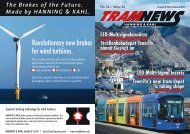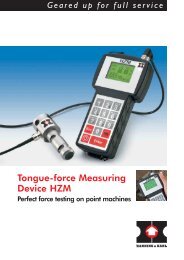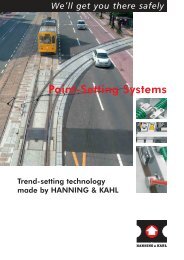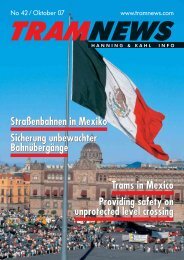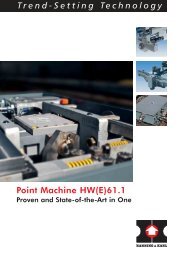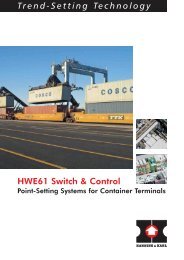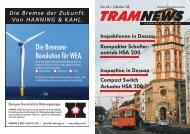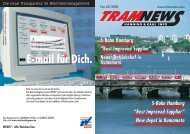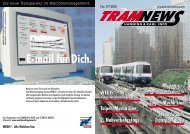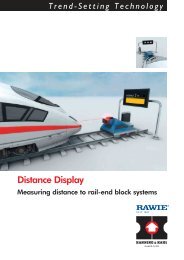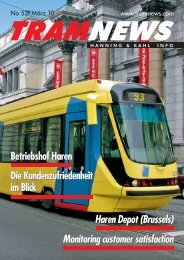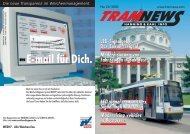Ein Notlösegerät für alle Fälle Gent Prüfung von ... - Hanning & Kahl
Ein Notlösegerät für alle Fälle Gent Prüfung von ... - Hanning & Kahl
Ein Notlösegerät für alle Fälle Gent Prüfung von ... - Hanning & Kahl
Erfolgreiche ePaper selbst erstellen
Machen Sie aus Ihren PDF Publikationen ein blätterbares Flipbook mit unserer einzigartigen Google optimierten e-Paper Software.
INTERVIEW<br />
Prüfung <strong>von</strong> Fahrsignalanlagen nach BoStrab<br />
Inspecting signalling installations in compliance with BoStrab tram regulations<br />
Heinrich Windus. Nach einer<br />
Elektrolehre und Abschluß des<br />
Studiums als Elektroingenieur,<br />
habe ich bei der Bundesbahn die<br />
Ausbildung für den gehobenen<br />
technischen Dienst der Fachrichtung<br />
Signal- und Fernmeldewesen<br />
absolviert. Danach war ich<br />
auf verschiedenen Gebieten der<br />
Planung, Prüfung und Abnahme<br />
<strong>von</strong> Signalanlagen tätig. Bei einer<br />
Beurlaubung zur Beratung<br />
für die Planung der Metro in Sao<br />
Paulo (Brasilien) hatte ich die ersten<br />
Berührungspunkte mit dem<br />
Nahverkehr. Als Sachverständiger<br />
bei der DB habe ich nebenberuflich<br />
für verschiedene Verkehrsbetriebe<br />
Prüfungen und<br />
Abnahmen für Zugsicherungsund<br />
Signalanlagen nach BO-<br />
Strab ausgeführt.<br />
Heinrich Windus. After an apprenticeship<br />
as an electrician and<br />
studying to be an electrical engineer,<br />
I completed a course of<br />
training with German Rail for an<br />
executive technical position, specialising<br />
in signalling and telecommunications.<br />
After that, I<br />
worked in different areas relating<br />
to the planning, inspection and<br />
acceptance of signalling installations.<br />
While on leave to advise on<br />
the planning of the metro in Sao<br />
Paulo (Brazil), I made my first<br />
contacts with light rail. In my capacity<br />
as an authorised inspector<br />
for the DB, I have carried out examinations<br />
and acceptance tests<br />
for train protection devices and<br />
signalling installations in accordance<br />
with the BOStrab regulations<br />
on the construction and<br />
operation of trams on behalf of<br />
different transport authorities.<br />
TRAM NEWS: Herr Windus,<br />
die Zusammenarbeit bei vielen<br />
Projekten zwischen Ihnen und<br />
HANNING & KAHL besteht<br />
seit mehreren Jahren. Wie lange<br />
sind Sie schon als Sachverständiger<br />
tätig<br />
WINDUS: Seit über 18 Jahren<br />
und zwar für Eisenbahnsignalund<br />
BÜ-Anlagen nach EBO mit<br />
Anerkennung für NE-Bahnen<br />
in verschiedenen Bundesländern.<br />
Seit über 12 Jahren bin ich als<br />
„sachkundige Person“ nach §5<br />
(2) der BOStrab für einige<br />
Technische Aufsichtsbehörden<br />
(TAB) tätig.<br />
TRAM NEWS: Sehr oft herrscht<br />
Unklarheit über die Prüfung<br />
<strong>von</strong> Fahrsignalanlagen<br />
und Weichensteuerungen.<br />
Wenn wir <strong>von</strong> „Fahren auf<br />
Sicht“ sprechen, nach welchen<br />
Vorschriften prüfen Sie dann<br />
die Anlagen <br />
WINDUS: Beim „Fahren auf<br />
Sicht“ handelt es sich um<br />
Signalanlagen nach § 21 der<br />
BOStrab. Grundlage der Prüfung<br />
ist die BOStrab und<br />
dazu kommen die VDV-<br />
Schriften z.B. 341, Technische<br />
Sicherung der Bahnübergänge<br />
bei Straßenbahnen; 343,<br />
Weichensteuerungen im Sichtfahrbereich;<br />
344, Fahrsignalanlagen<br />
nach BOStrab<br />
§ 21.<br />
Für die Prüfung ist die VDV-<br />
Schrift 331, Anforderungsklassen<br />
für Signal- und Zugsicherungsanlagen<br />
gemäß BOStrab<br />
ein wichtiger Bestandteil.<br />
TRAM NEWS: Nach welchen<br />
Kriterien wird so eine Prüfung<br />
durchgeführt, und was sind<br />
nach ihrer Meinung die wichtigsten<br />
Punkte <br />
WINDUS: Hier ist die VDV-<br />
Schrift 331 eine wichtige<br />
Grundlage, um die Anforderungsklasse<br />
(AK) festzulegen.<br />
Die Prüfungen für die einzelnen<br />
AK ergeben sich aus der DIN V<br />
19250 „Grundlegende Sicherheitsbetrachtungen<br />
für MSR-<br />
Schutzeinrichtungen“ oder nach<br />
der europäischen Norm IEC 65<br />
(Sec) 123.<br />
TRAM NEWS: Wenn sich unser<br />
Kunde für die Prüfung seiner<br />
Steuerung durch einen<br />
Sachverständigen entscheidet,<br />
welche Vorteile hat dann diese<br />
Prüfung für ihn<br />
WINDUS: Nach § 5 (1) der<br />
BOStrab führt die TAB die erforderlichen<br />
Prüfungen, Zustimmungen<br />
und Abnahmen durch.<br />
Da die TAB oft nicht die Zeit<br />
oder das Personal hat, um diese<br />
Arbeiten zügig durchzuführen,<br />
kann sie sich nach §5 (2)<br />
anderer Personen bzw. Stellen<br />
bedienen.<br />
Für den Kunden ergibt sich der<br />
Vorteil dadurch, daß bei der<br />
Vorlage für den Bau <strong>von</strong> Betriebsanlagen,<br />
nach § 60, die<br />
TAB schneller den Zustimmungsbescheid<br />
erteilen kann,<br />
wenn sie nicht selbst prüfen<br />
muß.<br />
Dies trifft auch für die Abnahme<br />
nach § 62 zu.<br />
TRAM NEWS: Unsere Kunden<br />
haben in der Regel unterschiedliche<br />
Anlagentypen im<br />
<strong>Ein</strong>satz. Welche Anlagentypen<br />
können <strong>von</strong> Ihnen geprüft werden<br />
<br />
WINDUS: Hier muß man<br />
zunächst unterscheiden, ob bei<br />
den heute verwendeten Steuerungen,<br />
z.B. SPS oder bei sicheren<br />
Rechnersystemen ein Sicherheitsnachweis<br />
vorliegt.<br />
Da mit diesen Steuerungen<br />
Weichen, Fahrsignalanlagen,<br />
BÜ-Anlagen u.ä. betrieben<br />
werden können, ist eine Prüfung<br />
für den entsprechenden<br />
<strong>Ein</strong>satz erforderlich unter<br />
Berücksichtigung <strong>von</strong> Wünschen<br />
und Besonderheiten der<br />
Verkehrsbetriebe.<br />
Für diese <strong>Ein</strong>satzmöglichkeiten<br />
werden die Anlagen <strong>von</strong> mir<br />
geprüft.<br />
TRAM NEWS: Teilt sich die<br />
Prüfung durch einen Sachverständigen<br />
in mehrere Phasen<br />
auf und wenn ja, in welche<br />
Phasen <br />
WINDUS: Erforderlich sind 2<br />
Prüfungen: 1. Die Prüfung der<br />
Schaltung, nach § 60 der BO-<br />
Strab, um die Zustimmung zum<br />
Bau der Anlage zu erhalten.<br />
2. Die Abnahme, nach § 62 der<br />
BOStrab, damit die TAB den<br />
Abnahmebescheid und so die<br />
Zustimmung zum Betrieb der<br />
Anlage erteilt.<br />
Im praktischen Prüfverfahren<br />
hat sich eine weitere Prüfung<br />
zwischen diesen beiden Punkten,<br />
die Werksabnahme, ergeben.<br />
Durch die Werksabnahme<br />
kann mit der Simulation der<br />
Außenanlage die Funktionsfähigkeit<br />
der Anlage getestet<br />
und damit die Abnahme vor<br />
Ort vereinfacht werden.<br />
Ferner bietet die Abnahme im<br />
Werk die Möglichkeit, ohne<br />
großen Aufwand die Software<br />
zu prüfen.<br />
TRAM NEWS: Herr Windus,<br />
wir bedanken uns für das Gespräch<br />
und die Informationen.<br />
Die Fragen für die TRAM<br />
NEWS stellte Christian Schmidt,<br />
Leiter Auftragszentrum / Steuerungen,<br />
Geschäftsbereich<br />
Nahverkehr, HANNING &<br />
KAHL.<br />
TRAM NEWS: Mr Windus, you<br />
have worked together with<br />
HANNING & KAHL on many<br />
projects and for several years<br />
now. How long have you been<br />
working as an authorised inspector<br />
WINDUS: I have been inspecting<br />
railway signalling and level<br />
crossings in accordance with the<br />
EBO railway construction and<br />
operating regulations with permission<br />
to inspect secondary railways<br />
in different federal states<br />
for more than 18 years now.<br />
I have been working for more<br />
than 12 years as an “expert“<br />
acc. to §5 (2) of the BOStrab<br />
tram regulations for different<br />
technical supervisory boards<br />
(TAB).<br />
TRAM NEWS: There is often<br />
confusion about what the testing<br />
of signalling installations and<br />
point controllers involves. Whenever<br />
we talk about “Driving at<br />
sight“, what regulations do you<br />
use as the basis for testing the<br />
units <br />
WINDUS: "Driving at sight”<br />
implies signalling installations as<br />
described by § 21 of the BO-<br />
Strab. The examination is based<br />
on the BOStrab and the VDV<br />
guidelines e.g. 341, Technical<br />
safeguarding of level crossings<br />
for trams; 343, Point controllers<br />
in the driving at sight area; 344,<br />
Signalling installations according<br />
to BOStrab § 21.<br />
The VDV guideline 331, Safety<br />
requirement classes for signalling<br />
and train protection devices<br />
as stipulated by BOStrab are<br />
also extremely relevant for the<br />
examination.<br />
TRAM NEWS: What criteria is<br />
such an examination based on<br />
and what are the most important<br />
factors in your opinion<br />
WINDUS: The VDV guideline<br />
331 plays an important role in<br />
determining the required safety<br />
category. Then the DIN V<br />
19250 “Fundamental safety<br />
considerations for protective<br />
process measurement and control<br />
devices“ or the European<br />
standard IEC 65 (Sec) 123 is<br />
used to determine the inspections<br />
necessary to award the<br />
safety category.<br />
TRAM NEWS: If one of our customers<br />
decides to have his controller<br />
tested by an authorised<br />
inspector, what advantages<br />
does he gain from such a test<br />
WINDUS: § 5 (1) of the BO-<br />
Strab stipulates that the necessary<br />
inspections and acceptance<br />
tests be carried out and<br />
certified by the technical supervisory<br />
boards. However, in<br />
many cases, these authorities<br />
have neither the time nor the<br />
staff to carry out such work<br />
quickly and therefore §5 (2) allows<br />
them to engage other<br />
people or institutions to do so.<br />
The customer profits from the<br />
fact that the technical supervisory<br />
board can issue the certificate<br />
of assent faster whenever<br />
they do not have to carry out<br />
the inspections themselves. This<br />
accelerates the whole submission<br />
process prior to the construction<br />
of operating units, as<br />
stipulated by § 60. This also applies<br />
to acceptance according<br />
to § 62.<br />
TRAM NEWS: Our customers<br />
generally have different types<br />
of units in deployment. Which<br />
types of units can you test <br />
WINDUS: First of all, you must<br />
determine whether the controllers<br />
deployed today, e.g. PLC or<br />
failsafe computer-controlled systems<br />
have their own safety certificates.<br />
As these controllers can be deployed<br />
to operate points, signalling<br />
installations and level<br />
crossings etc, the examination<br />
must be made on the basis of<br />
the deployment function required<br />
taking the wishes and particular<br />
requirements of the transport<br />
authorities into consideration.<br />
I test the units for such deployment<br />
possibilities.<br />
TRAM NEWS: Is the examination<br />
that the authorised inspector<br />
carries out divided into<br />
several phases and if yes, what<br />
are these phases <br />
WINDUS: Two examinations<br />
are necessary:<br />
1. The examination of the circuit<br />
stipulated by § 60 of the BO-<br />
Strab, this is necessary in order<br />
to obtain approval to build the<br />
unit.<br />
2. The factory acceptance test<br />
stipulated by § 62 of the BO-<br />
Strab, this must be carried out<br />
before the TAB awards the acceptance<br />
certificate and grants<br />
permission for the operation of<br />
the unit.<br />
In practice, however, a further<br />
examination takes places between<br />
these two items, viz. the<br />
factory acceptance test. By simulating<br />
the external unit, the<br />
factory acceptance test makes it<br />
possible to test the operatability<br />
of the unit which in turn simplifies<br />
the acceptance test on the<br />
location.<br />
The factory acceptance test also<br />
affords an excellent opportunity<br />
to test the software in the<br />
factory without any great effort.<br />
TRAM NEWS: Mr Windus,<br />
thank you for this interview and<br />
for the information.<br />
The interviewer for TRAM<br />
NEWS was Christian Schmidt,<br />
Head of the Order-processing<br />
Centre / Controllers, Light Rail<br />
Division, HANNING & KAHL.<br />
14<br />
15



